In the first part of the article, adriaticnature has already mentioned that Ernest Hemingway was fond of sea fishing. But he is definitely not the only one. When you look at the photos of one of the most famous baseball players in the history of sports, Ted Williams, with his catches, once again you can mention that first of all you remember the quality and beauty of the image instead of the trophy. adriaticnature will devote a separate article to taking photos while fishing. But now, let’s return to the fish species you should aim for on vacation at the Adriatic Sea.

(Ted Williams. Photo by © wsj.com)
Horse mackerel is a summer predator, caught with the spinnerbaits. Both summer and interseasonal ones. In April-May, it is constantly becoming larger.
Three species of the Carangidae family can be caught in the course of beach casting in the Adriatic when you use sport gear. Horse mackerel weighing 500 grams “plus” is considered to be a late spring, summer and early-autumn catch. If you warm up the water, you can count on catching specimens weighing about a kilogram.
Here are the fish that can be found hunting near the beaches: schools of fry often jump out to the flat sand shore trying to swim away from horse mackerels chasing them; at the debouchures, horse mackerels often attacks the fry and forms small “traps” surrounding and forcing them to the surface.

(Horse mackerel. Photo by © adriaticnature)
The following lures are worth experimenting: small metal jigs, from minimal weights up to 15-20 grams, small stick baits (relatively heavy sinking baits, similar to minnow, but without a “minnow” spade) up to 7 centimeters long, as well as poppers, walkers and plugs, medium-sized soft plastic lures, which in most cases are cast into water using a “bombarda”, that is, a float-shaped weight lead, serving, in this case, for the long-distance casting of a light lure.
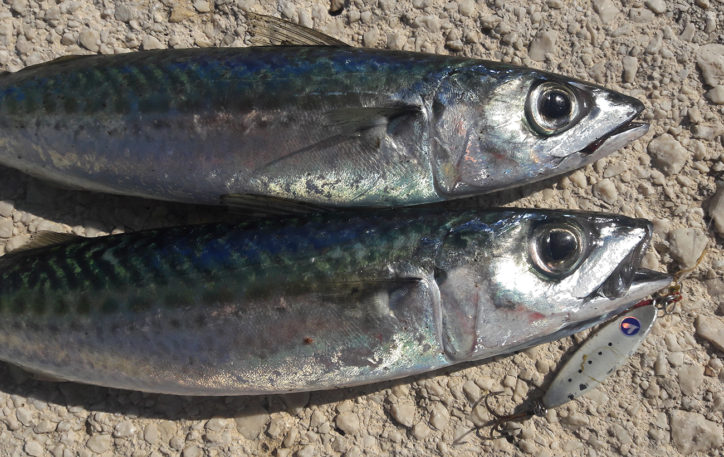
(Atlantic mackerel. Photo by © adriaticnature)
Although scombers prefer depths, they can’t resist the easy prey – the fry, coming to the littoral shelf, when water becomes warmer. In the Adriatic Sea, there are two species of Scomber – Atlantic mackerel and Atlantic chub mackerel. And both of these species can be caught being at the shore, using small jigs or plugs. Chances to meet these predators at a casting distance are higher in spring and autumn. Fish is often rather small – up to 200 grams, less often 400 grams, but catching them brings pleasure for sure.

(Garfish. Photo by © adriaticnature)
Garfish acts similar to horse mackerel, but more modestly as for observed occurrences, in summer and off-season, when the weather is warm enough. There are small “traps” with the fry swimming away from the predator and jumping out to the surface. More often this can be observed in the open sea near the rocky coast. Small jigs and soft plastic lures with light jig-heads with the use of a “bombarda” are the best recipe for catching the predator with a long “beak”.
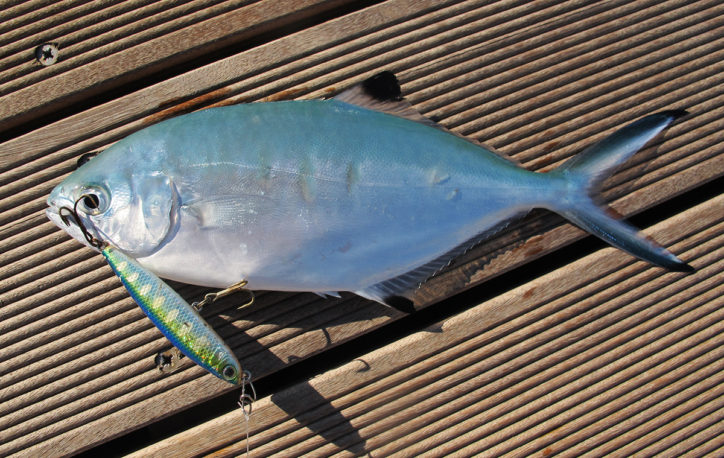
(Pompano. Photo by © adriaticnature)
When the water gets warmer, the fourth rather small predator acts in a similar way. The peak of its activity coincides with spring and autumn. Most often it occurs in the sea bays. Moreover, this silverfish, pompano, adores miniature soft plastic lures and jigs. You will definitely enjoy catching it with light fishing gear because its combativity is enormous. It rarely exceeds 300 grams, more often specimens up to 250 grams are found.
All the year-round, the evening-night predators are caught with the feeder or the usual fishing line for bottom fishing (even during the day). These fishes feel like the twilight kings of the bottom. These invisible masters of the near-shore are European eel, conger and muraena.

(European eel. Picture by © Lubomir Hlasek. hlasek.com)
Unlike European eel, which is more often found in bays, river mouths and rivers that flow into the sea, conger and muraena don’t really like freshwater, hiding in the rocks and other shelters of rather deep areas of the sea, leaving them to hunt on the sand shoals of the beaches and other open places at night.
European eels are tempted with baits of animal origin, including fish cuts, scraps of meat or squid. Spring and autumn are the best time for catching it.
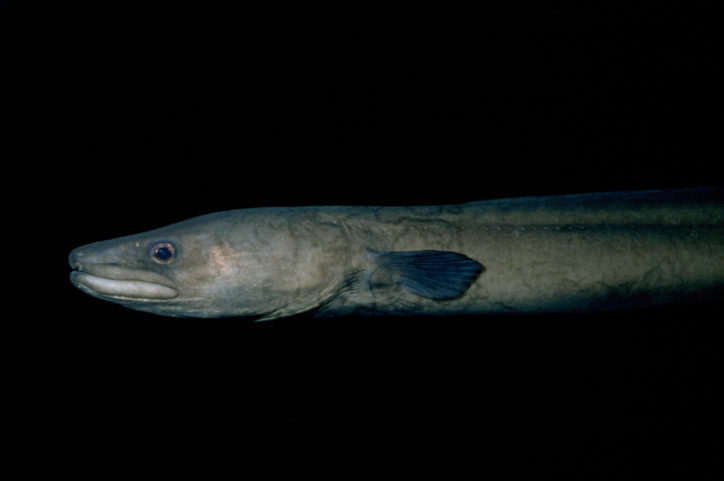
(European conger. Photo by © Rudie H. Kuiter / Aquatic Photographics. fishesofaustralia.net.au)
Congers and muraenas are caught using the same baits, but the size of both the bait and the fish is larger. And the teeth of the latter are dangerous not only for fishing lines and cords but also for anglers in case of inappropriate handling. Therefore, be careful, when you take them off the hooks, and use metal hooklinks, when fishing.
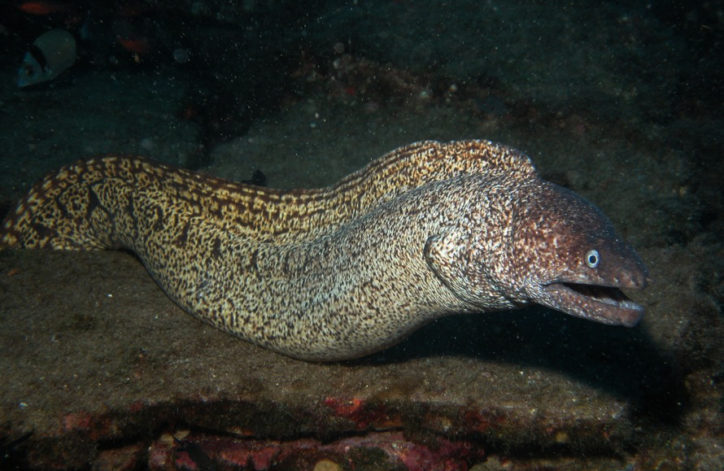
(Mediterranean moray. Photo by inokean.ru)
Many fish species that occur in the catches of fans of fishing with spinning rods and those who like to fish with float gear and leger rig using natural baits. Some of them are family members of the gilt-head bream. In most cases, they have oval-shaped bodies, flattened on the sides, quite steep “foreheads”. They are a little similar to freshwater bream (common bream) as regards their constitutional peculiarities. Apparently, the family got its name – sea breams – because of this fact. Some of them weigh 200-500 grams, others – 15 kilograms and more. Some of them don’t have obvious predatory tendencies, but occasionally they are caught with spinning lures.
Let’s try to figure out these seabreams.
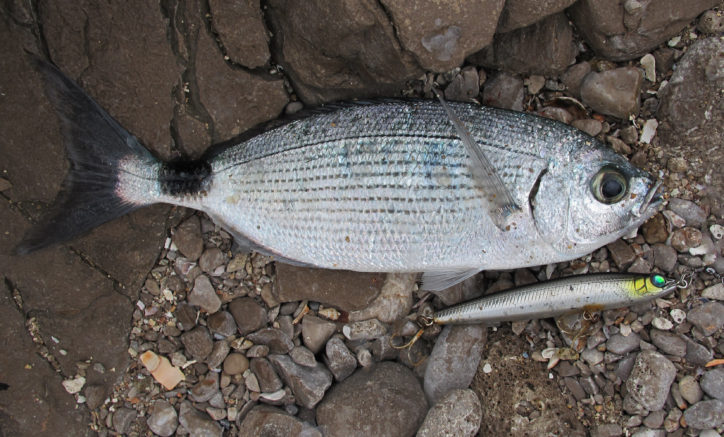
(Saddled seabream. Photo by © adriaticnature)
If you are on the shores of the Adriatic Sea at the time when the winds are blowing and there are storms at sea, another inhabitant of this sea won’t let you fall into despair. It is saddled seabream, or oblade. Waves influence this seabream like a calling alarm. Saddled bream hunts and attacks actively everything it sees, including small soft plastic lures, plugs, jigs, walkers.
Since small twisters and shads can’t boast of their good flying features, they are successfully used for fishing with bombarda.
This schooling fish, weighing usually up to 200-300 grams, will bring a lot of pleasure in the process of catching it with a light spinning kit. The main thing is to find the right place for fishing.
Its natural environment is rocks and rocky bottom. But, if you found a part of the sea with a strong current – you definitely should look for saddled breams, without paying attention to whether the wind is blowing or not, and whether the sea is calm or there are waves at sea.